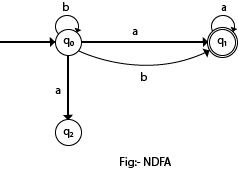About N.D.F.A :-
-->A nondeterministic finite automaton (NFA), or nondeterministic finite-state machine, does not need to obey these restrictions. In particular, every DFA is also an NFA. Sometimes the term NFA is used in a narrower sense, referring to an NFA that is not a DFA, but not in this article.
Using the subset construction algorithm, each NFA can be translated to an equivalent DFA; i.e., a DFA recognizing the same formal language. Like DFAs, NFAs only recognize regular languages.
NFAs were introduced in 1959 by Michael O. Rabin and Dana Scott, who also showed their equivalence to DFAs. NFAs are used in the implementation of regular expressions: Thompson's construction is an algorithm for compiling a regular expression to an NFA that can efficiently perform pattern matching on strings. Conversely, Kleene's algorithm can be used to convert an NFA into a regular expression (whose size is generally exponential in the input automaton) -->The finite automata are called NFA when there exist many paths for specific input from the current state to the next state. Every NFA is not DFA, but each NFA can be translated into DFA. NFA is defined in the same way as DFA but with the following two exceptions, it contains multiple next states, and it contains ε transition.
-->In the following image, we can see that from state q0 for input a, there are two next states q1 and q2, similarly, from q0 for input b, the next states are q0 and q1. Thus it is not fixed or determined that with a particular input where to go next. Hence this FA is called non-deterministic finite automata.

->NFA also has five states same as DFA, but with different transition function, as shown follows:
δ : Q x ∑ →2Q
where,
Q: finite set of states
∑: finite set of the input symbol
q0: initial state
F: final state
δ: Transition function
--> An NFA can be represented by digraphs called state diagram. In which:
-The state is represented by vertices.
-The arc labeled with an input character show the transitions.
-The initial state is marked with an arrow.
-The final state is denoted by the double circle.
Examples:-
1. NDFA with ∑ = {0, 1} accepts all strings with 01.-->

Since the condition here is that it accepts the string starts with '01'. No dead state will denote here for the undesirable string condition.
2. NDFA with ∑ = {0, 1} and accept all string of length atleast 2
-->
Since it accepts only the string of length 2, so there is no self loop and also not any dead state will be drawn for any undesirable condition.
3. Design an NFA with ∑ = {0, 1} accepts all string ending with 01.
-->

Since at last of the string there must be 01 no matter what the stream of input symbol are behind '01'.




Comments
Post a Comment